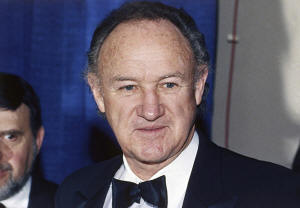Actor Gene Hackman, prolific Oscar winner, found dead at home at 95
years old
 [February 27, 2025]
LOS ANGELES (AP) — Gene Hackman, the prolific Oscar-winning actor
whose studied portraits ranged from reluctant heroes to conniving
villains and made him one of the industry’s most respected and honored
performers, has been found dead along with his wife at their home. He
was 95. [February 27, 2025]
LOS ANGELES (AP) — Gene Hackman, the prolific Oscar-winning actor
whose studied portraits ranged from reluctant heroes to conniving
villains and made him one of the industry’s most respected and honored
performers, has been found dead along with his wife at their home. He
was 95.
His dozens of films included Oscar-winning roles in “The French
Connection” and “Unforgiven,” a breakout performance in “Bonnie and
Clyde,” a comic interlude in “Young Frankenstein," a turn as the comic
book villain Lex Luthor in “Superman” and the title character in Wes
Anderson’s 2001 “The Royal Tenenbaums.”
He seemed capable of any kind of role — whether an uptight buffoon in
“Birdcage,” a college coach finding redemption in the sentimental
favorite “Hoosiers” or a secretive surveillance expert in Francis Ford
Coppola’s Watergate-era release “The Conversation.”
A plain-looking man with a receding hairline, Hackman held special
status within Hollywood — heir to Spencer Tracy as an everyman, actor’s
actor and reluctant celebrity. He embodied the ethic of doing his job,
doing it very well, and letting others worry about his image. The
industry seemed to need him more than he needed the industry. Beyond the
obligatory appearances at awards ceremonies, he was rarely seen on the
social circuit and made no secret of his disdain for the business side
of show business.
“Actors tend to be shy people,” he told Film Comment in 1988. “There is
perhaps a component of hostility in that shyness, and to reach a point
where you don’t deal with others in a hostile or angry way, you choose
this medium for yourself.”

He was an early retiree — essentially done, by choice, with movies by
his 70s — and a late bloomer. Hackman was in his mid-30s when cast for
“Bonnie and Clyde” and past 40 when he won his first Oscar, as the
rules-bending New York detective “Popeye” Doyle in the 1971 thriller
about tracking down Manhattan drug smugglers, “The French Connection.”
Jackie Gleason, Steve McQueen and Peter Boyle were among the actors
considered for the role. Hackman was a minor star at the time, seemingly
without the flamboyant personality that the role demanded. The actor
himself feared that he was miscast. A couple of weeks of nighttime
patrols of Harlem in police cars helped reassure him.
One of the first scenes of “The French Connection” required Hackman to
slap around a suspect. The actor realized he had failed to achieve the
intensity that the scene required, and asked director William Friedkin
for another chance. The scene was filmed at the end of the shooting, by
which time Hackman had immersed himself in the loose-cannon character of
Popeye Doyle. Friedkin would recall needing 37 takes to get the scene
right.
“I had to arouse an anger in Gene that was lying dormant, I felt, within
him — that he was sort of ashamed of and didn’t really want to revisit,”
Friedkin told the Los Angeles Review of Books in 2012.
[to top of second column]
|

In this 1993 file photo, actor Gene Hackman is seen. (AP
Photo/File)
 Hackman also resisted the role which
brought him his second Oscar. When Clint Eastwood first offered him
Little Bill Daggett, the corrupt town boss in “Unforgiven,” Hackman
turned it down. But he realized that Eastwood was planning to make a
different kind of western, a critique, not a celebration of
violence. The film won him the Academy Award as best supporting
actor of 1992.
“To his credit, and my joy, he talked me into it,” Hackman said of
Eastwood during an interview with the American Film Institute.
Eugene Alden Hackman was born Jan. 30, 1931, in San Bernardino,
California, and grew up in Danville, Illinois, where his father
worked as a pressman for the Commercial-News. His parents fought
repeatedly, and his father often used his fists on Gene to take out
his rage. The boy found refuge in movie houses, identifying with
Errol Flynn and James Cagney as his role models.
When Gene was 13, his father waved goodbye and drove off, never to
return. The abandonment was a lasting injury to Gene. His mother had
become an alcoholic and was constantly at odds with her mother, with
whom the shattered family lived (Gene had a younger brother). At 16,
he “suddenly got the itch to get out.” Lying about his age, he
enlisted in the U.S. Marines.
“Dysfunctional families have sired a lot of pretty good actors,” he
observed ironically during a 2001 interview with The New York Times.
In 1956, Hackman married Fay Maltese, a bank teller he had met at a
YMCA dance in New York. They had a son, Christopher, and two
daughters, Elizabeth and Leslie, but divorced in the mid-1980s. In
1991 he married Betsy Arakawa, a classical pianist of Japanese
descent who was raised in Hawaii.
When not on film locations, Hackman enjoyed painting, stunt flying,
stock car racing and deep sea diving. In his latter years, he wrote
novels and lived on his ranch in Sante Fe, New Mexico, on a hilltop
looking out on the Colorado Rockies, a view he preferred to his
films that popped up on television.
“I’ll watch maybe five minutes of it,” he once told Time magazine,
“and I’ll get this icky feeling, and I turn the channel.”
__
AP National Writer Hillel Italie in New York and Entertainment
Writer Andrew Dalton in Los Angeles contributed to this report. Bob
Thomas, a longtime Associated Press journalist who died in 2014,
compiled biographical material for this obituary.
All contents © copyright 2025 Associated Press. All rights reserved
 |